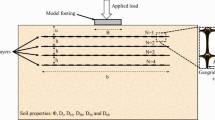Abstract
This paper examines the potential of relevance vector machine (RVM) in prediction of ultimate capacity of driven piles in cohesionless soils. RVM is a Bayesian framework for regression and classification with analogous sparsity properties to the support vector machine (SVM). In this study, RVM has been used as a regression tool. It can be seen as a probabilistic version of SVM. In this study, RVM model outperforms the artificial neural network (ANN) model based on root-mean-square-error (RMSE) and mean-absolute-error (MAE) performance criteria. It also estimates the prediction variance. An equation has been developed for the prediction of ultimate capacity of driven piles in cohesionless soils based on the RVM model. The results show that the RVM model has the potential to be a practical tool for the prediction of ultimate capacity of driven piles in cohesionless soils.












Similar content being viewed by others
References
Abu Kiefa MA (1998) General regression neural networks for driven piles in cohesionless soils. J Geotech Geoenviron Eng 124(12):1177–1185
Berger JO (1985) Statistical decision theory and Bayesian Analysis, 2nd edn., Springer, New York
Chan WT, Chow YK, Liu LF (1995) Neural network: an alternative to pile driving formula. Comput Geotech 17:135–156
Chow YK, Chan LF, Liu LF, Lee SL (1995) Prediction of pile capacity from stress-wave measurements: a neural network approach. Int J Numer Anal Methods Geomech 19:107–126
Coyle HM, Castello RR (1981) New design correlations for piles in sand. J Geotech Eng 107(7):965–986
Ghaboussi J (1992) Potential application of neuro-biological computational models in geotechnical engineering. Numerical models in geomechanices 1992. In: Pande GN, Pietruszezak S (eds), Balkemma, Rotterdam, The Netherlands, pp 543–555
Goh ATC (1995) Empirical design in geotechnics using neural networks. Geotechnique 45(4):709–714
Goh ATC, Goh SH (2007) Support vector machines: their use in geotechnical engineering as illustrated using seismic liquefaction data. Comput Geotech 34:410–421
Kecman V (2001) Learning and soft computing: support vector machines, neural networks, and fuzzy logic models. The MIT press, Cambridge, Massachusetts
Lee IM, Lee JH (1996) Prediction of pile bearing capacity using artificial neural network. Comput Geotech 18(3):189–200
Maalouf M, Khoury N, Trafalis TB (2008) Support vector regression to predict asphalt mix performance. Int J Numer Anal Methods Geomech 32:1989–1996
MacKay DJ (1992) Bayesian methods for adaptive models. Ph.D. thesis, Department of comput and neural syst., Calif Institute of Technology, Pasadena, California
MathWork Inc (1999) Matlab user’s manual. Natick, MA: The MathWorks, Inc., Version 5.3
Mayoraz F, Vulliet L (2002) Neural networks for slope movement prediction. Int J Geomech 2:153–173
Meyerhof GG (1976) Bearing capacity and settlement of pile foundation. J Geotech Eng 102(3):196–228
Neal R (1994) Bayesian learning for neural networks. Ph.D. Thesis: University of Toronto, Tronto, Quebe, Canada
Pal M (2006) Support vector machines-based modelling of seismic liquefaction potential. Int J Numer Anal Methods Geomech 30:983–996
Park D, Rilett LR (1999) Forecasting freeway link ravel times with a multi-layer feed forward neural network. Comput Aided Civil Infrastructure Eng 14:358–367
Randolph MF (1985) Capacity of piles driven into dense sand. Rep. Soils TR 171, Department of Engineering, Cambridge University
Randolph MF, Dolwin J, Beck R (1994) design of driven piles in sand. Ge′otechnique 44(3):427–448
RP2A (1984) Recommended practice for planning, designing and constructing fixed offshore platforms, 15th edn. American petroleum Institute, Washington, DC
RP2A (1991) Recommended practice for planning, designing and constructing fixed offshore platforms, 19th edn. American petroleum Institute, Washington, DC
Samui P, Kumar B (2006) Artificial neural network prediction of stability numbers for two-layered slopes with associated flow rule. Electron J Geotech Eng 11
Samui P, Sekar SK (2011) Utilization of Support Vector Machine (SVM) for Prediction of Ultimate Capacity of Driven Piles in Cohesionless Soils. In Support Vector Machines: Data Analysis, Machine Learning and Applications, Nova Publishers, USA
Tipping ME (2000) The relevance vector machine. Adv Neural Inf Process Syst 12:625–658
Tipping ME (2001) Sparse Bayesian learning and the relevance vector machine. J Mach Learn 1:211–244
Wahba G (1985) A comparison of GCV and GML for choosing the smoothing parameters in the generalized spline-smoothing problem. Ann Stat 4:1378–1402
Author information
Authors and Affiliations
Corresponding author
Rights and permissions
About this article
Cite this article
Samui, P. Application of Relevance Vector Machine for Prediction of Ultimate Capacity of Driven Piles in Cohesionless Soils. Geotech Geol Eng 30, 1261–1270 (2012). https://doi.org/10.1007/s10706-012-9539-9
Received:
Accepted:
Published:
Issue Date:
DOI: https://doi.org/10.1007/s10706-012-9539-9




